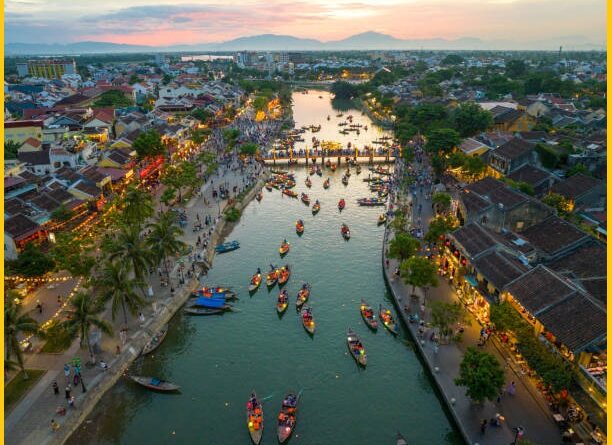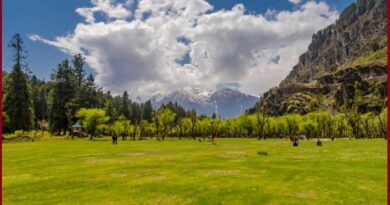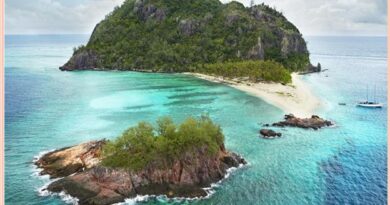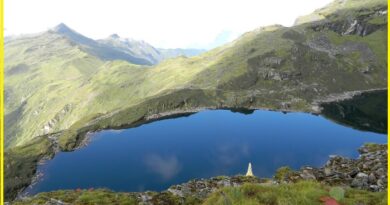Vietnam
Vietnam is a Southeast Asian country known for its rich history, diverse culture, delicious cuisine, and stunning natural landscapes. Vietnam is situated in Southeast Asia, bordered by China to the north, Laos, and Cambodia to the west, and the South China Sea to the east and south. The country has a diverse geography, including mountains, deltas, rivers, and coastlines. The Mekong Delta in the south and the Red River Delta in the north are two major river deltas, which are crucial to Vietnam’s agriculture.
History: Vietnam has a long and complex history, marked by periods of independence, colonization, and war. It was ruled by China for much of its early history, followed by periods of French colonization and Japanese occupation during World War II. After the defeat of the French in the First Indochina War, Vietnam was divided into North Vietnam and South Vietnam, leading to the Vietnam War. The war ended with the reunification of the country under communist rule in 1975.
Vietnam’s culture is a blend of indigenous traditions, Chinese influence, and colonial legacies. Confucianism, Buddhism, and Taoism have all played significant roles in shaping Vietnamese culture, along with French colonial influence. Vietnamese cuisine is renowned worldwide for its fresh ingredients, complex flavors, and regional variations. Traditional Vietnamese music, dance, and art also reflect the country’s cultural diversity.
Tourism: Vietnam is a popular tourist destination, offering a wide range of attractions for visitors. From the bustling streets of Ho Chi Minh City (formerly Saigon) to the serene landscapes of Ha Long Bay, there’s something for everyone in Vietnam. Other popular destinations include the ancient town of Hoi An, the imperial city of Hue, the capital city of Hanoi, and the beautiful beaches of Da Nang and Nha Trang. Outdoor enthusiasts can enjoy trekking in the northern mountains, exploring caves in Phong Nha-Ke Bang National Park, or relaxing on the sandy shores of Phu Quoc Island.
Vietnam Attractions map
This is the Vietnam Map, the map includes the most popular tourist destinations. Vietnam travel destinations include Hanoi, Ha Giang, Sapa, Hue, Ho Chi Minh City, and Ha Long Bay.

Vietnam Attractions
Vietnam is a country with a rich history, diverse culture, stunning natural landscapes, and vibrant cities. Here are some of the top attractions in Vietnam:
Ha Long Bay
Ha Long Bay, located in northeastern Vietnam, is one of the most iconic natural attractions in the country and a UNESCO World Heritage Site. Ha Long Bay is renowned for its breathtaking scenery, characterized by thousands of limestone karsts and islets rising dramatically from the emerald waters of the Gulf of Tonkin. The towering limestone formations are topped with lush vegetation, creating a surreal landscape that has captivated visitors for centuries.
Also read- 10 Most Beautiful Places to Travel on Vietnam Island
UNESCO World Heritage Site: Ha Long Bay was designated as a UNESCO World Heritage Site in 1994 in recognition of its outstanding natural beauty and geological significance. It is considered one of the most impressive examples of marine karst landscapes in the world. One of the best ways to experience Ha Long Bay is by taking a cruise or boat tour. There are a variety of options available, ranging from day trips to multi-day excursions aboard traditional wooden junks or luxury cruise ships. Cruises typically include visits to scenic spots, caves, fishing villages, and opportunities for activities such as kayaking and swimming. Ha Long Bay is dotted with numerous limestone caves and grottoes, each with its own unique features and formations. Some of the most popular caves to explore include Sung Sot Cave (Surprise Cave), Thien Cung Cave (Heaven Palace Cave), and Hang Đầu Gỗ (Wooden Stakes Cave).
The bay is also home to several floating fishing villages, where local communities live in traditional wooden houses built on stilts. Visiting these villages offers insight into the traditional way of life of the local fishermen and their families. In addition to cruising and cave exploration, Ha Long Bay offers a range of outdoor activities such as swimming, snorkeling, kayaking, and hiking. The calm and clear waters of the bay are ideal for water-based activities, while the surrounding islands and islets provide opportunities for exploration and adventure.
Hoi An Ancient Town
Hoi An Ancient Town is a charming UNESCO World Heritage Site located on the central coast of Vietnam and best Vietnam Attractions. Hoi An was a bustling trading port during the 15th to 19th centuries, attracting merchants from China, Japan, Europe, and other parts of Asia. The town’s architecture and culture reflect its diverse heritage, with influences from Chinese, Japanese, French, and Vietnamese traditions.
Hoi An’s historic district is renowned for its well-preserved architecture, characterized by traditional wooden buildings, ancient temples, colorful shop-houses, and ornate pagodas. The streets are lined with lanterns, creating a magical atmosphere, especially at night. Hoi An is famous for its Lantern Festival, held on the 14th day of each lunar month. During the festival, the town is adorned with colorful lanterns, and traditional performances, music, and food stalls create a lively atmosphere. Floating lanterns are released onto the Thu Bon River, creating a mesmerizing sight.
One of the most iconic landmarks in Hoi An is the Japanese Covered Bridge, also known as Cau Pagoda. Built in the 16th century, this beautifully preserved bridge features intricate carvings and a small temple dedicated to the god of weather. Hoi An is renowned for its delicious cuisine, which blends Vietnamese, Chinese, and French influences. Don’t miss the opportunity to sample local specialties such as cao lau (noodle dish), mi Quang (turmeric-infused noodles), and banh mi (Vietnamese sandwich).
Ho Chi Minh City (Saigon)
Ho Chi Minh City, also known as Saigon, is the largest city in Vietnam and a vibrant hub of culture, commerce, and history. Independence Palace or Reunification Palace is an iconic building that served as the headquarters of the South Vietnamese government during the Vietnam War and is now a museum showcasing its history. War Remnants Museum offers a sobering look at the Vietnam War through photographs, artifacts, and exhibits documenting the conflict and its impact. Notre Dame Cathedral Built in the late 19th century, this beautiful cathedral is a striking example of French colonial architecture and a city symbol.
Hue
Hue, located in central Vietnam, was the imperial capital of the Nguyen Dynasty from 1802 to 1945 and best Vietnam Attractions. Steeped in history and culture, Hue is a UNESCO World Heritage Site and a treasure trove of ancient architecture, imperial tombs, and scenic landscapes. The centerpiece of Hue is the Imperial City, a vast complex surrounded by thick walls and a moat. Within the citadel, you’ll find the Forbidden Purple City, once reserved for the emperor and his family, as well as numerous palaces, temples, and pavilions.
Flowing through the heart of Hue, the Perfume River is named for the fragrant flowers that fall into the water from orchards upstream. Take a boat cruise along the river to enjoy views of the city skyline and visit attractions such as Thien Mu Pagoda, one of the oldest pagodas in Vietnam. Hue is home to several magnificent royal tombs, each reflecting the personality and tastes of the emperor for whom it was built. Some of the most notable tombs include the Tomb of Minh Mang, the Tomb of Khai Dinh, and the Tomb of Tu Duc, set amidst lush gardens and scenic landscapes.
Located in the countryside outside of Hue, Thanh Toan Bridge is a beautiful covered bridge dating back to the 18th century. Visit the nearby Thanh Toan Village to experience rural life and explore a traditional agricultural museum. Experience the sights, sounds, and smells of Hue at Dong Ba Market, one of the oldest and busiest markets in the city. Wander through the stalls selling fresh produce, seafood, handicrafts, and souvenirs, and sample local delicacies at the food stalls.
Sapa
Sapa is a picturesque town nestled in the Hoang Lien Son mountain range of northwest Vietnam, near the border with China. Famous for its stunning terraced rice fields, ethnic minority communities, and rugged landscapes, Sapa is a popular destination for trekking, cultural immersion, and outdoor adventures. Sapa is renowned for its breathtaking scenery, characterized by terraced rice fields cascading down the mountainsides, mist-shrouded valleys, and towering peaks. The landscape changes dramatically with the seasons, with vibrant green rice paddies in the summer and golden hues in the autumn.
Sapa is home to several ethnic minority groups, including the Hmong, Dao, Tay, and Giay people, each with their own distinct cultures, traditions, and languages. Visitors can trek to remote villages, interact with local communities, and learn about their way of life, traditional crafts, and customs. Sapa offers excellent trekking opportunities for outdoor enthusiasts of all levels. Whether you’re embarking on a multi-day trek to conquer Fansipan, the highest peak in Indochina, or exploring scenic trails through rice terraces and bamboo forests, there are routes to suit every preference and fitness level.
For those seeking a more leisurely way to experience the beauty of Sapa’s landscapes, the Fansipan Cable Car offers a scenic ride to the summit of Fansipan Mountain. From the cable car, you can enjoy panoramic views of the surrounding mountains and valleys. Sapa’s bustling markets are vibrant hubs of activity, where ethnic minority traders gather to sell their wares. The Sapa Market held daily in the town center, offers a colorful array of handicrafts, textiles, traditional clothing, and local produce. The Bac Ha Market, located about 60 kilometers from Sapa, is another must-visit market known for its lively atmosphere and diverse offerings.
Phong Nha-Ke Bang National Park
Phong Nha-Ke Bang National Park is a UNESCO World Heritage Site located in central Vietnam and Vietnam Attractions. Renowned for its stunning karst landscapes, extensive cave systems, and rich biodiversity, Phong Nha-Ke Bang is a paradise for nature lovers, adventurers, and those seeking to explore Vietnam’s hidden treasures.
Karst Landscapes: Phong Nha-Ke Bang is characterized by dramatic limestone karst formations, towering cliffs, and lush forests, creating a picturesque and rugged landscape. The park’s karst terrain is one of the most extensive in the world, with over 300 caves and grottoes scattered throughout the area. The park is home to some of the world’s most spectacular caves, including Son Doong Cave, the largest cave in the world, and Hang En Cave, one of the largest cave passages by volume. Visitors can explore these caves on guided tours, marveling at their colossal chambers, stunning rock formations, and underground rivers.
Two of the most popular caves in the park are Phong Nha Cave and Paradise Cave. Phong Nha Cave features a subterranean river and impressive stalactites and stalagmites, while Paradise Cave is known for its otherworldly beauty, with intricate calcite formations illuminated by colorful lights. In addition to cave exploration, Phong Nha-Ke Bang offers a range of outdoor activities for adventure seekers. You can go trekking through the park’s pristine forests, kayaking along the Son River, zip-line through the jungle canopy, or cycle through picturesque villages and rice paddies.
Phong Nha-Ke Bang is not only a natural wonder but also holds cultural significance, with evidence of human habitation dating back thousands of years. The park’s caves and rock shelters contain ancient cave paintings, artifacts, and archaeological sites, providing insight into the region’s prehistoric past.
Ninh Binh Vietnam
Ninh Binh, located in northern Vietnam, is often referred to as “Halong Bay on land” due to its similar limestone karst landscapes and it is the best Vietnam Attractions. Tam Coc, also known as the “Halong Bay on land,” is a scenic area characterized by limestone karst formations, rice paddies, and winding rivers. Visitors can take a leisurely boat ride along the Ngo Dong River, passing through caves and towering karsts, while enjoying the picturesque scenery.
Another UNESCO World Heritage Site in Ninh Binh, Trang An Landscape Complex is renowned for its karst topography, caves, and rich biodiversity. Visitors can explore the complex by boat, passing through caves and navigating narrow waterways surrounded by lush greenery. Bai Dinh Pagoda is one of the largest Buddhist pagodas in Vietnam, encompassing a vast complex of temples, shrines, and statues. Highlights include the Bai Dinh Tower, the giant bronze Buddha statue, and the stunning views from the top of the pagoda complex.
Hoa Lu was the ancient capital of Vietnam during the Dinh and Early Le dynasties in the 10th and 11th centuries. The site features ancient temples, pagodas, and royal palaces set amidst scenic landscapes. Visitors can explore the historical relics and learn about Vietnam’s feudal history. Mua Cave offers panoramic views of the surrounding countryside from its summit. To reach the top, visitors must climb a staircase of over 500 steps, but the effort is rewarded with breathtaking views of the karst landscapes, rice fields, and the winding Ngo Dong River.
Danang Vietnam
Da Nang, located on the central coast of Vietnam is a vibrant city and best Vietnam Attractions. My Khe Beach is one of the most famous beaches in Da Nang, known for its soft white sand, clear blue waters, and gentle waves. It’s a popular spot for swimming, sunbathing, and water sports such as surfing and jet skiing.
The Marble Mountains are a cluster of five limestone hills named after the five elements: Thuy (Water), Moc (Wood), Hoa (Fire), Kim (Metal), and Tho (Earth). Visitors can explore caves, pagodas, and grottoes nestled within the mountains, as well as enjoy panoramic views of the surrounding area from the hilltops. Son Tra Peninsula is a scenic area located just north of Da Nang city center, known for its lush forests, winding roads, and panoramic viewpoints. The peninsula is home to the famous Linh Ung Pagoda and offers opportunities for hiking, wildlife viewing, and photography.
The Dragon Bridge is an iconic landmark in Da Nang, known for its unique design featuring a dragon-shaped structure that spans the Han River. The bridge is illuminated at night and breathes fire and water on weekends, making it a popular spot for evening strolls and photo opportunities. The Han River waterfront is a bustling area with restaurants, cafes, and bars lining the riverbanks. Visitors can take a stroll along the riverfront promenade, enjoy a river cruise, or dine at one of the many riverside eateries offering delicious local cuisine.

Dalat Vietnam
Dalat, located in the Central Highlands of Vietnam, is a picturesque city known for its cool climate, stunning landscapes, and French colonial architecture. Xuan Huong Lake is an artificial lake in the heart of Dalat and offers scenic views, walking paths, and paddleboat rentals. It’s a popular spot for locals and tourists to relax and enjoy the peaceful surroundings.
Valley of Love or Thung Lung Tinh Yeu is a romantic park in a picturesque valley and features flower gardens, lakes, and walking trails. It’s a popular destination for couples and honeymooners, with scenic viewpoints and photo opportunities. Dalat Flower Gardens is Known as the City of Flowers, Dalat is famous for its colorful blooms and flower gardens. The Dalat Flower Gardens showcase a wide variety of flowers, including roses, orchids, and hydrangeas, in beautifully landscaped gardens.
Linh Phuoc Pagoda is a Buddhist temple known for its intricate mosaic artwork made from broken ceramic tiles and glass bottles. The pagoda features a 49-meter-long dragon sculpture and stunning architecture, making it a unique and photogenic attraction. Lang Biang Mountain is a majestic mountain the highest peak in the Dalat area, offering panoramic views of the surrounding countryside. Visitors can hike or take a jeep ride to the summit, enjoying breathtaking vistas and exploring the mountain’s diverse ecosystems.
Mui Ne
This coastal town is famous for its red and white dunes, perfect for sandboarding or dune buggy rides. Mui Ne is also known for its beautiful beaches and unique fishing village. Nha Trang: This coastal city is renowned for its pristine beaches, clear waters, and vibrant coral reefs, making it a popular destination for snorkeling and scuba diving. Da Nang: Known for its beautiful beaches and modern bridges, Da Nang is also home to the Marble Mountains, a cluster of five marble and limestone hills with caves, temples, and panoramic views. Cu Chi Tunnels: Located outside of Ho Chi Minh City, these underground tunnels were used by the Viet Cong during the Vietnam War. Visitors can explore a portion of the tunnels and learn about the hardships faced by soldiers during the war.
Ho to Reach Vietnam Attractions
Reaching Vietnam typically involves flying into one of the major international airports in the country. Vietnam has several international airports, with the two main ones being Noi Bai International Airport in Hanoi, the capital city, and Tan Son Nhat International Airport in Ho Chi Minh City, the largest city in Vietnam. Other international airports include Da Nang International Airport in Da Nang and Cam Ranh International Airport in Nha Trang.
Post Views: 432





